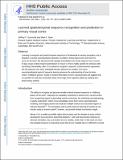| dc.contributor.author | Gavornik, Jeffrey | |
| dc.contributor.author | Bear, Mark | |
| dc.date.accessioned | 2016-04-29T14:23:08Z | |
| dc.date.available | 2016-04-29T14:23:08Z | |
| dc.date.issued | 2014-03 | |
| dc.date.submitted | 2014-01 | |
| dc.identifier.issn | 1097-6256 | |
| dc.identifier.issn | 1546-1726 | |
| dc.identifier.uri | http://hdl.handle.net/1721.1/102331 | |
| dc.description.abstract | Learning to recognize and predict temporal sequences is fundamental to sensory perception and is impaired in several neuropsychiatric disorders, but little is known about where and how this occurs in the brain. We discovered that repeated presentations of a visual sequence over a course of days resulted in evoked response potentiation in mouse V1 that was highly specific for stimulus order and timing. Notably, after V1 was trained to recognize a sequence, cortical activity regenerated the full sequence even when individual stimulus elements were omitted. Our results advance the understanding of how the brain makes 'intelligent guesses' on the basis of limited information to form visual percepts and suggest that it is possible to study the mechanistic basis of this high-level cognitive ability by studying low-level sensory systems. | en_US |
| dc.description.sponsorship | Howard Hughes Medical Institute | en_US |
| dc.description.sponsorship | Picower Institute for Learning and Memory (Innovation Fund) | en_US |
| dc.description.sponsorship | National Institute of Mental Health (U.S.) (Grant K99MH099654) | en_US |
| dc.language.iso | en_US | |
| dc.publisher | Nature Publishing Group | en_US |
| dc.relation.isversionof | http://dx.doi.org/10.1038/nn.3683 | en_US |
| dc.rights | Article is made available in accordance with the publisher's policy and may be subject to US copyright law. Please refer to the publisher's site for terms of use. | en_US |
| dc.source | PMC | en_US |
| dc.title | Learned spatiotemporal sequence recognition and prediction in primary visual cortex | en_US |
| dc.type | Article | en_US |
| dc.identifier.citation | Gavornik, Jeffrey P, and Mark F Bear. “Learned Spatiotemporal Sequence Recognition and Prediction in Primary Visual Cortex.” Nat Neurosci 17, no. 5 (March 23, 2014): 732–737. | en_US |
| dc.contributor.department | Massachusetts Institute of Technology. Department of Brain and Cognitive Sciences | en_US |
| dc.contributor.department | Picower Institute for Learning and Memory | en_US |
| dc.contributor.mitauthor | Gavornik, Jeffrey | en_US |
| dc.contributor.mitauthor | Bear, Mark | en_US |
| dc.relation.journal | Nature Neuroscience | en_US |
| dc.eprint.version | Author's final manuscript | en_US |
| dc.type.uri | http://purl.org/eprint/type/JournalArticle | en_US |
| eprint.status | http://purl.org/eprint/status/PeerReviewed | en_US |
| dspace.orderedauthors | Gavornik, Jeffrey P; Bear, Mark F | en_US |
| dc.identifier.orcid | https://orcid.org/0000-0001-8420-8973 | |
| mit.license | PUBLISHER_POLICY | en_US |
